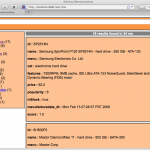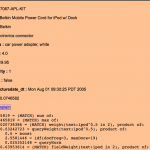Solritas: Solr 1.4’s Hidden Gem
Solr 1.4 contains a little advertised feature that I think folks ought to know about, Solritas. What a silly name, you say! Yeah, ok, call it the boring ol’ VelocityResponseWriter if you like. Pronunciation accessibility aside, Solritas makes Solr responses look like a real user interface. Close enough for government work, as they say. We’ve effectively used Solritas on a number of our recent engagements. After bringing clients’ data into Solr for the first time, wow, they have a search box, facets, and even toggle-able inline hit score explanations and request/response dumps (when using &debugQuery=true). And we like to toss the clients’ logo in the upper left for good measure, because we can and it’s easy.
Follow a few straightforward steps to enable Solritas on the example application which ships with Solr 1.4:
- Add the VelocityResponseWriter libraries directory to the example solrconfig.xml
- Register it as a response writer plugin, named “velocity”.
- Copy a templates directory –
cp -R contrib/velocity/src/main/solr/conf/velocity example/solr/conf/velocity
- And while we’re at it, we’ll create a nicely named (URLs matter too) request handler mapping that defaults to the velocity writer type, and a few other basic settings that make sense for the example data.
A diff of the only configuration file touched here, solrconfig.xml, is provided at the end to give you the details of the above steps.
Now Start up Solr
cd example java -jar start.jar
Index the example data (from another shell)
cd example/exampledocs java -jar post.jar *.xml
and visit http://localhost:8983/solr/itas. It should looks something like this screenshot:
Hey, I want my XML back! Ok, append &wt=xml to the URL; it’s the same results, just presented differently.
Adding debugQuery=true to a request, we get a pleasant inline view of Lucene’s explanation for the score computation of each result, see for yourself at http://localhost:8983/solr/itas?q=ipod&debugQuery=true, looks something like this, with explanations initially hidden and toggled into visibility individually by clicking the “toggle explain” link that now appears:
There’s a lot of interesting power and potential lurking within Solritas. Here are a few notable existing capabilities:
- Templates are searched for in the request parameters, a file system base directory, and the classpath – in that order. This allows the requesting client to override a sub-template such as the header, on a per-request basis, plugins bundled in JAR files may contain their own templates, and the file system can override embedded templates.
- Several useful “tools” (as Velocity calls them) are available to format numbers and dates, URL encode strings, and other practically necessary utilities to make data presentable to humans and hyperlinks.
- Straightforward access within a template to the entire Solr request and response objects
The following diffs are the only changes needed to light up Solritas on Solr 1.4’s example application –
48a49,51 > <!-- Added path to VelocityResponseWriter library and dependencies --> > <lib dir="../../contrib/velocity/src/main/solr/lib"/> > 501a505,525 > <!-- /itas mapping for Solritas view with some basic good defaults: like dismax, facet on cat --> > <requestHandler name="/itas"> > <lst name="defaults"> > <str name="v.template">browse</str> > <str name="title">Solritas Demonstration</str> > > <str name="wt">velocity</str> > <str name="defType">dismax</str> > <str name="q.alt">*:*</str> > <str name="rows">10</str> > <str name="fl">*,score</str> > <str name="facet">on</str> > <str name="facet.field">cat</str> > <str name="facet.mincount">1</str> > <str name="qf"> > text^0.5 features^1.0 name^1.2 sku^1.5 id^10.0 manu^1.1 cat^1.4 > </str> > </lst> > </requestHandler> > > 1006a1031,1033 > <!-- Light up VelocityResponseWriter --> > <queryResponseWriter name="velocity" class="org.apache.solr.request.VelocityResponseWriter"/> >

